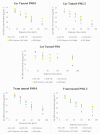Oxidative potential of PM1, PM2.5, and PM10 collected in car and tram tunnels to analyse their impact on public health
- PMID: 40596723
- PMCID: PMC12214819
- DOI: 10.1038/s41598-025-09037-4
Oxidative potential of PM1, PM2.5, and PM10 collected in car and tram tunnels to analyse their impact on public health
Abstract
Airborne particulate matter (PM) is a major environmental health risk, partly due to its oxidative potential (OP), which reflects its ability to generate reactive oxygen species. This study evaluates the OP of PM10, PM2.5, and PM1 fractions collected in car and tram tunnels in Krakow, Poland, using ascorbic acid (AA) and reduced glutathione (GSH) depletion assays. PM samples were collected during 2016 and analysed for organic carbon (OC), elemental carbon (EC), inorganic ions (Na+, K+, Mg2+, Ca2+, NH4+, NO3-, NO2-, Cl-, and SO42-), and metals (Cl, K, Ca, Ti, V, Cr, Mn, Fe, Ni, Cu, Zn, Br, Sr, Rb, Pb). PM concentrations ranged from 8 to 298 µg/m3 in the car tunnel and 31 to 127 µg/m3 in the tram tunnel. The depletion rates of AA and GSH varied by PM size fraction and tunnel type. Significant positive correlations were observed between OP indicators and redox-active metals, bromine, OC, and polycyclic aromatic hydrocarbons in the tram tunnel. In the car tunnel, stronger associations were found with inorganic ions. The strength of correlations was classified as strong, moderate, or weak to aid interpretation. Our findings highlight differences in the chemical drivers of OP between traffic and tram-related environments, suggesting that PM from combustion processes exerts greater oxidative stress potential than PM influenced by secondary inorganic aerosols. Even short exposure to PM10, PM2.5, and PM1 caused substantial antioxidant depletion, indicating potential respiratory health impacts. This study emphasises the importance of considering PM chemical composition, beyond mass concentration alone, when evaluating its health effects.
Keywords: Air pollution; Airborne particulate matter toxicity; Antioxidants; Environmental pollution; Heavy metals; Trace elements.
© 2025. The Author(s).
Conflict of interest statement
Declarations. Competing interests: The authors declare no competing interests.
Figures







References
-
- Lal, S. R. B. Public health measures to prevent the adverse impact of air pollution on health. Biol. Med.s3, (2015).
-
- Arora, M., Giuliani, A. & Curtin, P. The essentiality of dynamic interfaces in Human-Environment interactions. 10.20944/preprints201912.0325.v1 (2019).
-
- Jakhar, R., Samek, L. & Styszko, K. 2023 A comprehensive study of the impact of waste fires on the environment and health Sustainability. 15, 14241. 10.3390/su151914241 (2019).
-
- Samek, L., Stegowski, Z., Styszko, K., Furman, L. & Fiedor, J. Seasonal contribution of assessed sources to submicron and fine particulate matter in a central European urban area. Environ. Pollut.241, 406–411 (2018). - PubMed
MeSH terms
Substances
LinkOut - more resources
Full Text Sources
Research Materials
Miscellaneous

